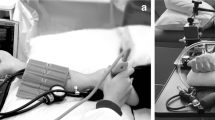Abstract
Objective
There is a close link between heart failure and endothelial dysfunction. Brachial flow-mediated dilation (FMD) is a validated non-invasive measure of endothelial function. The aim of this study was to investigate the clinical correlates of FMD in patients with chronic heart failure (CHF).
Design, setting, patients
We evaluated 60 CHF outpatients (age 62 ± 14 years; 49 males, NYHA class 2.2 ± 0.7, left ventricular ejection fraction, LVEF, 33 ± 8%) taking conventional medical therapy (ACE-inhibitors and/or ARBs 93%, beta-blockers 95%) and in stable clinical conditions.
Main outcome measures
The maximum recovery value of FMD was calculated as the ratio of the change in diameter (maximum-baseline) over the baseline value.
Results
As compared with patients with a higher FMD, those with FMD below the median value (4.3%) were more frequently affected by ischemic cardiopathy (50 vs. 23%; p = 0.032) and diabetes mellitus (20 vs. 3%; p = 0.044), had a higher NYHA class (2.5 ± 0.5 vs. 1.9 ± 0.7; p < 0.001) and NT-proBNP (2,690 ± 3,690 vs. 822 ± 1,060; p = 0.001), lower glomerular filtration rate estimated by Cockcroft-Gault (GFRCG: 63 ± 28 vs. 78 ± 25; p = 0.001) and LVEF (29 ± 8 vs. 37 ± 9; p = 0.001), as well as more frequently showing a restrictive pattern (40 vs. 7%; p = 0.002). In a multivariate regression model (R 2 = 0.48; p < 0.001), FMD remained associated only with the NYHA class (p = 0.039) and diabetes mellitus (p = 0.024).
Conclusions
This study demonstrates that a better functional status and absence of diabetes mellitus are associated to higher FMD regardless of the etiology of the cardiac disease.

Similar content being viewed by others
References
Kubo SH, Rector TS, Bank AJ, Williams RE, Heifetz SM (1991) Endothelium-dependent vasodilation is attenuated in patients with heart failure. Circulation 84:1589–1596
Kasprzak JD, Kosiñska M, Drozdz J (2006) Clinical aspects of assessment of endothelial function. Pharmacol Rep 58(Suppl 3):33–40
Joannides R, Haefeli WE, Linder L et al (1995) Nitric oxide is responsible for flow-dependent dilatation of human peripheral conduit arteries in vivo. Circulation 91:1314–1319
Cai H, Harrison DG (2000) Endothelial dysfunction in cardiovascular diseases: the role of oxidant stress. Circ Res 87:840–844
Anderson TJ, Uehata A et al (1995) Close relation of endothelial function in the human coronary and peripheral circulations. J Am Coll Cardiol 26:1235–1241
ESC Committee for Practice Guidelines (2008) ESC Guidelines for the diagnosis and treatment of acute and chronic heart failure 2008. Eur J Heart Fail 10:933–989
Lang RM, Bierig M, Devereux RB et al (2006) Recommendations for chamber quantification. Eur J Echocardiogr 7:79–108
Xie GY, Berk MR, Smith MD, Gurley JC, DeMaria AN (1994) Prognostic value of Doppler transmitral flow patterns in patients with congestive heart failure. J Am Coll Cardiol 24:132–139
Guyatt GH, Pugsley SO, Sullivan MJ et al (1984) Effect of encouragement on walking test performance. Thorax 39:818–822
Cockroft DW, Gault MH (1976) Prediction of creatinine clearance from serum creatinine. Nephron 16:31–41
Hillege HL, Girbes AR, de Kam PJ et al (2000) Renal function, neurohormonal activation, and survival in patients with chronic heart failure. Circulation 102:203–210
Corretti MC, Anderson TJ, Benjamin EJ et al (2002) Guidelines for the ultrasound assessment of endothelial-dependent flow-mediated vasodilation of the brachial artery: a report of the International brachial artery reactivity task force. J Am Coll Cardiol 39:257–265
Mancini GB (2002) Emerging role of angiotensin II type 1 receptor blockers for the treatment of endothelial dysfunction and vascular inflammation. Can J Cardiol 18(12):1309–1316
Husain S, Andrews NP, Mulcahy D et al (1998) Aspirin improves endothelial dysfunction in atherosclerosis. Circulation 97:716–720
Yiginer O, Ozcelik F, Inanc T et al (2008) Allopuriol improves endothelial function and reduces oxidant-inflammatory enzyme of myeloperoxidase in metabolic syndrome. Clin Res Cardiol 97(5):334–340
Clarkson P, Celermajer DS, Donald AE et al (1996) Impaired vascular reactivity in insulin-dependent diabetes mellitus is related to disease duration and low density lipoprotein cholesterol levels. J Am Coll Cardiol 28:573–579
Tentolouris C, Tousoulis D, Antoniades C et al (2004) Endothelial function and proinflammatory cytokines in patients with ischemic heart disease and dilated cardiomyopathy. Int J Cardiol 94:301–305
Agnoletti L, Curello S, Bachetti T et al (1999) Serum from patients with severe heart failure downregulates eNOS and is proapoptotic role of tumor necrosis factor. Circulation 100:1983–1991
Shah A, Gkaliagkousi E, Ritter JM, Ferro A (2010) Endothelial function and arterial compliance are not impaired in subjects with heart failure of non-ischemic origin. J Card Fail 16(2):114–120
Watts GF, Playford DA (1998) Dyslipoproteinaemia and hyperoxidative stress in the pathogenesis of endothelial dysfunction in non-insulin dependent diabetes mellitus: an hypothesis. Atherosclerosis 141:17–30
Yeboah J, Crouse JR, Hsu FC et al (2007) Brachial flow-mediated dilation predicts incident cardiovascular events in older adults the cardiovascular health study. Circulation 115:2390–2397
Shechter M, Matetzky S, Arad M, Feinberg MS, Freimark D (2009) Vascular endothelial function predicts mortality risk in patients with advanced ischaemic chronic heart failure. Eur J Heart Fail 11(6):588–593
Meyer B, Mörtl D, Strecker K et al (2005) Flow-mediated vasodilation predicts outcome in patients with chronic heart failure: comparison with B-type natriuretic peptide. J Am Coll Cardiol 46(6):1011–1018
Vittorio TJ, Zolty R, Garg PK et al (2009) Interdependence of cardiac and endothelial function in patients with symptomatic chronic heart failure of nonischemic etiology. Echocardiography 26(8):916–921
Ronco C, Haapio M, House AA, Anavekar N, Bellomo R (2008) Cardiorenal syndrome. J Am Coll Cardiol 52:1527–1539
Smilde TDJ, Damman K, van der Harst P (2009) Differential associations between renal function and “modifiable” risk factors in patients with chronic heart failure. Clin Res Cardiol 98(2):121–129
Conflict of interest
None declared.
Author information
Authors and Affiliations
Corresponding author
Rights and permissions
About this article
Cite this article
Ciccone, M.M., Iacoviello, M., Puzzovivo, A. et al. Clinical correlates of endothelial function in chronic heart failure. Clin Res Cardiol 100, 515–521 (2011). https://doi.org/10.1007/s00392-010-0275-y
Received:
Accepted:
Published:
Issue Date:
DOI: https://doi.org/10.1007/s00392-010-0275-y




